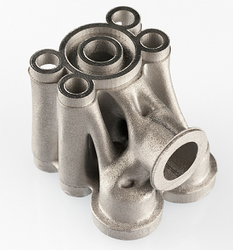
3D printing of high-performance, cost-effective, light-weight components
Additive manufacturing (AM) is opening up new business opportunities by freeing design from the restrictions of traditional manufacturing processes, enabling customization, and speeding up product time-to-market. Together, VTT Technical Research Centre of Finland Ltd and Nurmi Cylinders Oy have developed a cost-efficient, 3D-printed, reliable hydraulic valve block that is 66% lighter than the original part. 3D printing, also called additive manufacturing or AM technology, enables the production of objects of nearly any shape without the limitations associated with traditional manufacturing methods. Combined with advanced design and optimization techniques, the potential cost-savings of AM extends to the design phase where simulation can reduce the number of necessary design iterations. This technology also enables small, one-off production runs, which remove the additional costs typically associated with customization.
A new hydraulic valve block has been optimized to take full advantage of the benefits of 3D printing. The result is a product that is 66% smaller than the original design – leading to savings in weight, space and material. The valve block, which is used to control hydraulic cylinders that move under loads applied via the hydraulic fluid, can be found in cranes for example. Traditionally, the internal channels of the valve block are created with straight, circular drillings in a solid block of material. Additionally, several auxiliary drillings are needed, which are plugged and create the potential for leakages. With AM, the internal channels of the valve block can be optimized to optimize flow and save space, while the potential for leakage is removed because auxiliary drillings are no longer necessary.
“Using a laser for metal 3D printing is fairly new in Finland. Metal powder is spread one layer at a time and laser-melted at the desired areas. Unique, new materials are under development which will lead to new features and designs not yet commercially available. We have analysed the manufacturing costs and identified cost savings. In the future, this technique will give free hands for a designer, because manufacturing is not limiting geometries anymore,” says Senior Scientist Petri Laakso of VTT.
Together with the private sector, VTT engaged in a two-year project in November 2014 aiming to create new business within Finland with the use of AM technology. The overall project consists of the companies’ own projects and a research project by VTT, in which the companies are also participating. Tekes, the participating companies and VTT are providing the budgeted funding of three million euros. The project is part of VTT’s For Industry spearhead programme and its SME project startups.









